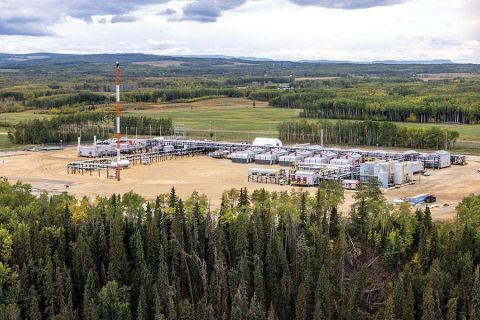
The U.S. hydrocarbon market has become decidedly liquid in the past decade as producers and midstream operators focus more on crude oil and natural gas liquids (NGL) and less on natural gas.
The U.S. Energy Information Administration (EIA) reported that natural gas plants liquids (NGPL) production has almost doubled in the period from 2010 to 2017, highlighted by an annual record of 3.7 million barrels per day (bbl/d) in 2017.
 These cumulative figures would have been even higher, but weak margins resulted in widespread ethane rejection between 2012 and 2015. Ethane prices began to recover in 2016 as demand increased with the opening of several U.S. ethane export terminals. Demand further increased in 2017 as two U.S.-based petrochemical plants opened.
These cumulative figures would have been even higher, but weak margins resulted in widespread ethane rejection between 2012 and 2015. Ethane prices began to recover in 2016 as demand increased with the opening of several U.S. ethane export terminals. Demand further increased in 2017 as two U.S.-based petrochemical plants opened.
According to the EIA, annual average U.S. NGPL production increased by almost 400,000 bbl/d between 2015 and 2017. Of this, about 175,000 bbl/d was attributed to increased ethane production. Ethane demand is expected to increase even further as more petrochemical plants are brought online this year and next.
Ethane production was already up a substantial 260,000 bbl/d in the first quarter of 2018 and the EIA expects ethane production to account for 52% of all NGPL growth between 2018 and the end of 2019.
Natural gas demand is also growing as more domestic LNG terminals are brought online. Since 2013, the U.S. and Australia have combined to add nearly 10 billion cubic feet per day (Bcf/d) of new liquefaction capacity. According to the EIA, the U.S. alone will add 6.05 Bcf/d of new liquefaction capacity by 2021.
As this capacity is added, the demand for natural gas will increase with prices following accordingly. These price increases will have an impact on frac spread margins, though their movement up or down will depend on whether natural gas or NGL prices rise first.
This week, NGL margins at Mont Belvieu were down slightly for most products as the price for natural gas was flat at $2.95 per million Btu (/MMBtu). Conway margins were up across the board with the price of natural gas falling just under 2% to $2.69/MMBtu.
Conway ethane prices reached a four-week high of 12 cents per gallon (/gal) as several facilities completed turnarounds, resulting in an increase in demand. However, margins remained negative at the hub since gas prices remained level. Fortunately, this was the only NGL with a negative margin at either hub.
 The Mont Belvieu price for ethane also hit a four-week high, as it was up to 33 cents/gal as exports out of the Gulf Coast are increasing. The margin at the hub was up 12%, though profitability is thin once transportation costs are factored in.
The Mont Belvieu price for ethane also hit a four-week high, as it was up to 33 cents/gal as exports out of the Gulf Coast are increasing. The margin at the hub was up 12%, though profitability is thin once transportation costs are factored in.
Propane prices are also benefitting from export demand as they are holding firm with only slight decreases outside of their peak season. The Mont Belvieu price was down 2 cents/gal to 85 cents/gal and the Conway price was flat at 66 cents/gal.
The largest drop in margin was for Conway ethane, which fell by 38%. This was followed by Mont Belvieu isobutane, which dropped 7% from last week. The NGL to have the biggest gain in margin was Mont Belvieu ethane at 12%. Conway C5+ had the second-largest gain in margin at 9%.
The theoretical NGL barrel price was down 1% at Mont Belvieu to $33.67 per barrel (/bbl) with a 1% decrease in margin to $22.89/bbl. The Conway theoretical barrel price rose 5% to $25.48/bbl with a 9% increase in margin to $15.64/bbl.
The most profitable NGL to make at both hubs was C5+ at $1.13/gal at Mont Belvieu and 97 cents/gal at Conway. This was followed, in order, by isobutane at 99 cents/gal at Mont Belvieu and 90 cents/gal at Conway; butane at 67 cents/gal at Mont Belvieu and 47 cents/gal at Conway; propane at 58 cents/gal at Mont Belvieu and 41 cents/gal at Conway; and ethane at 13 cents/gal at Mont Belvieu and negative 6 cents/gal at Conway.
 Natural gas in storage for the week of June 22, was 2.074 trillion cubic feet (Tcf). This was up 66 Bcf from the previous week and represents a decrease of 28% from the 2.81 Tcf reported last year at the same time. It's also down 20% from the five-year average of 2.58 Tcf.
Natural gas in storage for the week of June 22, was 2.074 trillion cubic feet (Tcf). This was up 66 Bcf from the previous week and represents a decrease of 28% from the 2.81 Tcf reported last year at the same time. It's also down 20% from the five-year average of 2.58 Tcf.
Cooling demand is expected to increase the first week of July. The National Weather Service is forecasting warmer-than-normal temperatures throughout the U.S., specifically the Northeast and Midwest. This should result in fuel demand from power plants across the country.
Recommended Reading
E&P Highlights: Nov. 4, 2024
2024-11-05 - Here’s a roundup of the latest E&P headlines, including a major development in Brazil coming online and a large contract in Saudi Arabia.
E&P Highlights: Sept. 23, 2024
2024-09-23 - Here's a roundup of the latest E&P headlines, including Turkey receiving its first floating LNG platform and a partnership between SLB and Aramco.
With Montney Production Set to Grow, US E&Ps Seize Opportunities
2024-10-02 - Canada’s Montney Shale play has already attracted U.S. companies Ovintiv, Murphy and ConocoPhillips while others, including private equity firms, continue to weigh their options.
Atlas Commissions 42-mile Dune Express Conveyor, Lowers 3Q Guidance
2024-10-10 - Atlas Energy Solutions said its Dune Express proppant conveyor remains on time and on budget, but the company expects lower revenue and EBITDA for the third quarter.
E&P Highlights: Oct. 28, 2024
2024-10-28 - Here’s a roundup of the latest E&P headlines, including a new field coming onstream and an oilfield service provider unveiling new technology.
Comments
Add new comment
This conversation is moderated according to Hart Energy community rules. Please read the rules before joining the discussion. If you’re experiencing any technical problems, please contact our customer care team.






